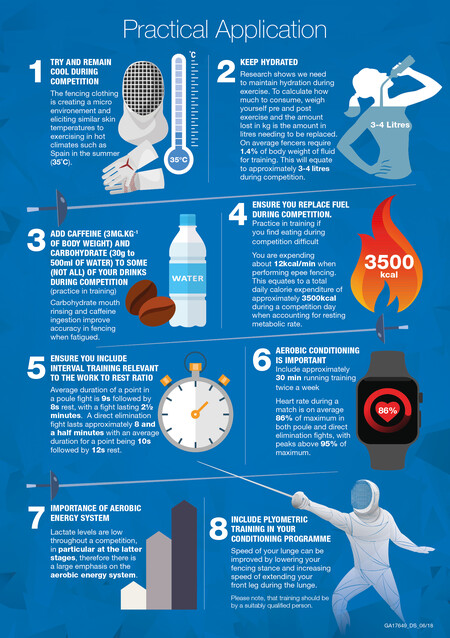We use cookies
Using our site means you agree to the use of cookies and similar technologies. Read about our policy and how to disable them here
Recently, I wrote a blog about how hot we get when we are fencing. This one is going to focus more on how hard we are working, but they are interlinked. We get hot because our body’s ability to use energy is inefficient. We lose 75% of energy through heat and only use 25% to enable the movement to happen. Therefore, the hotter we are, essentially means the harder we are working! When we get hot, we sweat as mentioned before – this means we need to replace fluids. If we don’t replace the sweat we lose, then fencing will get even harder. We need to pump blood around our body to ensure fuel is provided to the muscles as well as oxygen and then any waste products such as lactic acid and carbon dioxide are taken away and disposed of. If we lose fluid, our blood volume decreases so our heart must work harder to do this job. We can avoid this from happening if we keep hydrated! One easy way to ensure we hydrate enough is to weigh yourself before and after training and monitor how much fluid you consumed. For example, if you were 70kg before training and you drunk 300ml of water during training, then weighed yourself after and you were then 69Kg, essentially you lost approximately 1.3 L of fluid. If you do this a few times you will get an idea of your average sweat rate for a training session and you should then try and drink that much fluid. I would do the same for competition. On average for epee and foil we require about 1.4% of our body weight of fluid so this would almost be a litre for our 70kg person. In competition we are working harder and over the day we are needing to drink between 3-4 litres on average. What fluid should we drink, I will leave for another day!
How many calories do we burn during a competition?
We have done research with both epee and foil at the University of Hertfordshire. We managed to estimate energy expenditure during a simulated fencing competition by measuring the oxygen consumed and carbon dioxide expired. The fencers wore a face mask under their fencing mask which collected the gases and were analysed using a portable system. On average for foil and epee fencing you are using 11-12 Kcal per minute. This works out to be in the region of 3500 Kcal over the duration of a competition (assuming you get to the final stages). This means you need to replace these calories! So many fencers do not consider their nutrition during a competition. Admittedly, the structure of a competition can make it hard to plan for meals. But there are ways of eating easily digestible foods and replacing the fuel that is being used. In addition to the calories burnt it is interesting to note the work to rest ratios when fencing. Both foil and epee have similar work to rest ratios of around 1:1, which means for every 10 seconds of fencing there is about 10 seconds of rest. Sabre has a much lower work to rest ratio as the points are over a lot quicker so for every 5 seconds of fencing there is about 8 seconds of rest. When measuring heart rate responses during fencing we have found that epee and foil fencers are competing at around 85-88% of their maximum heart rate showing that the intensity is fairly high. Lactate increases in the blood when we are working at an intensity where we can’t clear it from the muscles as fast as producing it. We have found that blood lactate is not as high as we expected when fencing. Also, we found that as the competition went on the lactate responses decreased.
How do I use this information to help with my conditioning?
Understanding the heart rate responses, blood lactate responses and work to rest ratios helps us be more specific with our fencing training. When doing interval training such as footwork sessions, it is worth considering the work to rest ratios to keep it relevant to your weapon. It should also be noted, that part of your conditioning you need to be raising your heart rate to ensure you are training at the intensity you would compete at, if not above. Also, the work to rest ratios help us understand that there is a heavy reliance on explosive power which can be developed through the likes of plyometric training. But in contrast, the high heart rates and low blood lactate levels show an emphasis on aerobic conditioning. We can develop this through endurance training which involves intervals and long slow runs such as 30-minute runs. I know fencers hate running, but it is good for our conditioning for the sport. Admittedly, this would be less important for a sabre fencer as the durations of fights are much shorter.

Some of you will have seen this infographic before, but it summarises the information above. Essentially, let’s use the research we have done to help inform the practices we do…let’s train smart.

